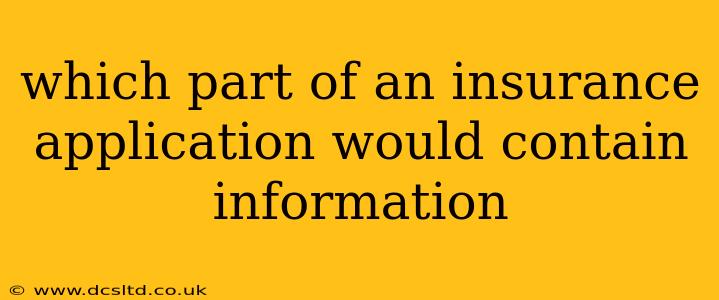Which Part of an Insurance Application Contains Information?
The answer to this question depends on what information you're looking for. An insurance application is a multifaceted document designed to gather comprehensive information about the applicant and the risk being insured. Different sections are dedicated to specific types of data. Let's break down the key sections and the information they typically contain.
1. Applicant Information: This section typically includes:
- Personal Details: Full name, address, date of birth, contact information, social security number (or equivalent national identifier). This is crucial for verification and identification purposes.
- Employment History: This often requires details such as current employer, job title, income, and length of employment. Insurers use this to assess financial stability and risk.
- Driving History: For auto insurance, this section demands a thorough account of driving history, including accidents, violations, and DUI/DWI convictions. This is vital for risk assessment.
- Medical History: For health, life, and disability insurance, this section requests detailed medical information, including pre-existing conditions, current treatments, and hospitalizations. This is critical for assessing the risk of future claims.
2. Property/Vehicle Information (for Property & Auto Insurance):
- Address & Details: This section will ask for the precise location and description of the property or vehicle being insured. This allows the insurer to accurately assess the risk.
- Value & Features: You'll likely be asked to provide an estimate of the property's value (for home or renters insurance) or the vehicle's value (for auto insurance). Specific features, like security systems or safety features, might also be requested.
3. Coverage Details: This section clarifies what kind of insurance you're applying for and the level of coverage desired:
- Type of Insurance: Specifies whether it's auto, home, life, health, etc.
- Coverage Amounts: This specifies the amount of financial protection sought. This can vary greatly depending on the type of insurance and individual needs.
4. Declarations and Signatures:
- Declaration of Accuracy: A statement confirming the accuracy of the information provided.
- Applicant Signature: This validates the application and indicates agreement to the terms and conditions.
What information is NOT typically found on an insurance application?
While applications are thorough, they generally don't contain highly sensitive personal information unrelated to the risk being assessed, such as:
- Detailed financial accounts: While income is important, specific bank statements or account details aren't usually required.
- Personal opinions or beliefs: The application focuses on factual data, not subjective opinions.
- Irrelevant medical history: Only medical history directly relevant to the type of insurance applied for will be requested.
How do I find the specific information I need?
The best way to locate specific information within an insurance application is by carefully reviewing the application itself. Most applications are organized logically, with clear headings and sections to guide you. If you are unsure about any information requested, it is always best to contact the insurance provider directly for clarification. They can explain what's needed and why.
